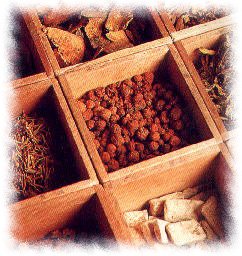Living & Values -- Medicine
A typical Chinese pharmacy look extremely different from a typical Western pharmacy. On shelves and in tidy drawers are animal, plant, and mineral products, each with a particular purpose. Among the assortment of medicines are amber to relax the nerves, peach pits and safflower to improve blood circulation, Chinese ephedra (mahuang) to induce perspiration, and ginseng to strengthen cardiac function.
When pharmacists fill the prescription ordered by a Chinese doctor, they select a few particular ingredients from the hundreds on their shelves. These are taken home by the patient, boiled into a soup, and drunk. Are you wondering what the basis of this ancient medical art is?
Tradition

|
The Chinese have a unique system of classifying illnesses that is widely divergent from the Western system. The philosophy behind Chinese medicine is that man lives between heaven and earth, and is a miniature universe in himself. The functions of living beings are described in terms of the following five centers of the body: "heart" or "mind"; this refers to the "command center" of the body, which manifests itself as consciousness and intelligence, "lungs" or "respiratory system"; this system regulates various intrinsic functions of the body, and maintains cybernetic balance, "liver"; this system includes the limbs and vertebra, the mechanism for emotional response to the external environment and the actions of organs, "spleen"; this organ system regulates the distribution of nutrition throughout the body and the metabolism, thereby, bringing strength and vigor to the physical body, and "kidneys"; this refers to the system for regulating the storage of nutrition and the use of energy. This theory is used to describe the system of body functions, and as a whole is referred to as the "latent phenomena".
According to Chinese medicine, the passage of the seasons and changes in the weather can have an influence on the human body. Those having the most pronounced effect are wind, cold, heat, moisture, dryness, and internal heat. Excessive or extraordinary changes in the weather harm the body, and are referred to as the "six external disease-causing factors". In addition, if mood changes within the individual, such as happiness, anger, worry, pensiveness, grief, fear, and surprise are too extreme, they will also harm the health. These emotions are called the "seven emotions". In Chinese medicine, the six external disease-causing factors, interacting with the seven emotions, form the theoretical foundation of disease pathology. These theoretical two models along with the "theory of latent phenomena" are used to analyze the patient's illness, and diagnose the exact nature of the patient's overall physical and psychological loss of balance. Based on this analysis, the doctor can prescribe a method to correct the imbalance. Chinese medicine focuses on the person, not just the illness. In Chinese medical thinking, illness is only one manifestation of an imbalance that exists in the entire person.
According to Chinese legend, Shen Nung, the Chinese father of agriculture and leader of an ancient clan, took it upon himself to test hundreds of different plants to discover their nutritional and medicinal properties. Many of these turned out to be poisonous to humans. Over the millennia, Chinese have continuously used themselves as guinea pigs to test plants for their properties of inducing cold, heat, warmth, and coolness. They classified the medicinal effects of the plants on the various parts of the body and then tested them to determine their toxicity, what dosages would be lethal.
The accumulation of experience strengthened the Chinese understanding of natural phenomena and increased the applications of natural principles in Chinese medicine. The same principles described in the preceding text are also applied to assess the patient's living environment, life rhythms, food preferences, personal relationships, and language and gestures. Applied in this way, the principles are used as a tool in better understanding the patient's illness, and suggesting improvements in various areas. Once the excesses or imbalances are pinpointed, they can be adjusted, and physical and mental health and balance restored. This attainment of equilibrium in the body's flow of energy is the ultimate guiding principle of Chinese medical treatment.
In addition to the prescription of medicines, acupuncture is another frequently used tool of treatment in Chinese medicine. Its history precedes written Chinese language, but acupuncture was not fully developed until after the Han dynasty. Its theoretical base is the adjustment of ch'i, or the flow of life energy. Ch'i flows through the body via the system of main and collateral channels of the body. At certain points along these channels, acupuncture needles may be inserted to adjust imbalances in the flow of ch'i and concentrate the body's self-healing powers in the necessary areas. In 1980, the World Health Organization released a list of 43 types of pathologies which can be effectively treated with acupuncture. The use of acupuncture as anesthesia during surgery or for painless childbirth is no longer news. Acupuncture is simple to administer, has few side effects, and has broad applications. It has opened up a vast field of scientific and medical research.
Today
Today, many people trained in both traditional Chinese and modern Western medical arts have made great contributions to the treatment of hepatitis, high blood pressure, cancer, and other diseases that are difficult to treat. In the area of pharmacology, researchers have evaluated effectiveness, analyzed, tested, and formulated concentrated dosages of Chinese pharmaceuticals for commercial sale. The prescriptions for these drugs are easier to fill, and are much more convenient for the patient than the old boiling method. In the area of basic science, modern research is being conducted in the field of pulse diagnosis. The three fingers used in the past to determine illness through the feeling of the pulse are now being replaced by pressure reactors. Many new discoveries have been made through unique combinations of traditional and modern science. The combination of modern scientific knowledge and precision with the art of traditional Chinese medicine has created a whole new world of medical diagnosis and treatment.



 Chinese Culture
Chinese Culture